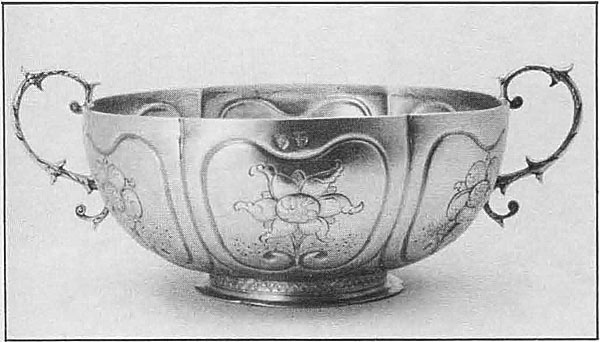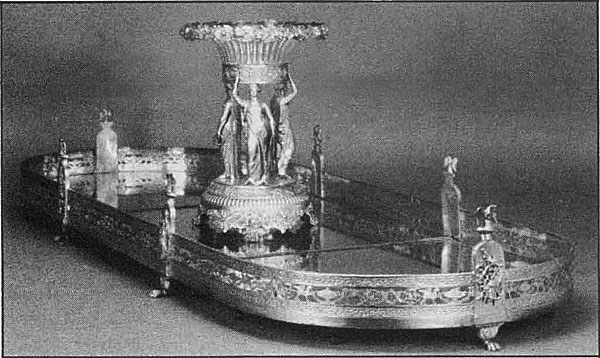quote:
American Silver: Worth its Weight in Gold 
This American ca 1707 silver bowl by New York City silversmith Benjamin Wynkoop sold at Sotheby's on November 17, 1981 for $121,000.
People get fed up collecting American silver because there isn't any around," says Eric Shrubsole of New York's S.J. Shrubsole. 18th-century silver made in the colonies is now so rare that relatively few people collect it compared to the numbers focusing on other Americana or on English and Continental silver. Those who do, wait patiently for the good pieces to trickle into the market at prices that stretch into the tens of thousands. When a rare piece of silver becomes available, it does not lack for a buyer."Very fine pre-Revolutionary American silver is as strong as ever in terms of its appeal and its demand," affirms people who buy the best silver have not been affected by the recession "1981 was a banner year" for the New York firm he represents. "At James Robinson we sold more at higher prices than ever before."
As in the rest of the art and antiques marketplace, middle range objects are nowadays harder to sell. One gauge of the market is the prestigious Winter Antiques Show held annually at the 7th Regiment Armory in New York. This year, Jonathan Trace of Putnam Valley, New York, had no trouble selling several extraordinary pieces of silver, as well as some inexpensive late Federal examples. "The middle-road things were slightly off."
If the acquisition of American silver follows many of the same patterns as other art and antiques, it also has its peculiarities. Buying for investment is rarely a motivation. "People like to know the value is there" but they rarely buy to sell, according to Munves. And silver is one antique that improves with use. When asked how to polish silver, one collector said, "You don't polish silver. You use it every day, washing it with soap and water." "When used and cleaned gently over the years silver attains a wonderful bluish gray color," says Christie's expert Dean Failey. To polish silver flatware means "putting chromium steel in your mouth and getting gangrene," adds Shrubsole.
While many owners use their silver, it is unlikely that the New York collector who purchased the most expensive piece of American silver ever sold at auction will serve strawberries and cream in his two-handled bowl made by Benjamin Wynkoop around 1707. The bowl, which Sotheby's auctioned for $121,000 on November 17, 1981, "represents the beginning of American silver," according to the auction house's specialist Kevin Tierney. Fewer than 20 bowls of this type, made in New York State between 1680 and 1730, are known to exist today. A similar bowl by the same silversmith has been on exhibition at The NewYork Historical Society since 1911. The age, rarity, size (8" diameter), beauty, and airtight provenance inspired the spectacular price for the $121,000 bowl.
The small elite of American silver collectors most passionately covets the earliest examples. 17th-century silver is so rare that a 1680 tankard might sell for around $50,000, according to Shrubsole. The earliest piece his firm has at the moment is a 1725 brazier by the Boston maker John Potwine-priced at $18,000. Teapots, chocolate pots, coffee pots, and sugar bowls are the most eagerly sought 18th-century forms. Shrubsole has a 1770 Joseph Richardson coffee pot for $45,000.
Not surprisingly, the magic of a name inspires extravagant purchases. In the 1960s, silver by Paul Revere, Jr. was far and away the most sought after. In the late] 960s Sotheby's sale of the Lansdell-Christie's splendid collection of Faberge, American furniture, and American silver, a Paul Revere tea set estimated at around $25,000, made headlines when it was gaveled at $70,000. Failey recalls that the resulting excitement brought a tremendous amount of Revere silver "out of the woodwork" and onto the auction block, where it sold for exceptionally high prices. A pair of silver tongs brought $5,250; a sauceboat, $52,000. With so much Revere becoming available prices dipped and then came back up, showing however, little advance in the intervening 12 years. Although other silversmiths can bring as much money now, Revere silver is still expensive. On January 23, Christie's sold a fluted oval form teapot by Revere for $36,000. If the base had not been repaired, it might have fetched as much as the similar Revere teapot

One of three known American silver plateaus. This ca 1825 example by John W. Forbes may break the $121,000 auction record for American silver when it is offered at Christie's on June 12.
that went for $55,000 in the Sotheby's November 17, 1981, sale. Even though a ca 1790 silver spoon had a worn tip, it sold in the Sotheby's sale for $1,650 because it was crafted by Revere. Silver by New York silversmith Myer Myers is also highly prized. A pear-shaped teapot made by him around 1755 was purchased at a January auction for $63,250.
For those collectors who cannot come up with so much cash, 18th-century silver is still attainable. Trace suggests that for a few hundred dollars one can purchase "nice" 18th-century flatware. If Shrubsole were beginning a collection with only $2,000 or $3,000 he might buy a mug or a cream jug.
More bargains are available in 19th-century American silver. "One weak area from the seller's point of view is 1810-1830," Failey suggests. At that time a technique developed in which the silver was rolled out very thin. Because the silver was thus cheaper than it had been before, more people bought it and more was made. Today this silver is fairly inexpensive because of its lightness and availability. Failey says a four-piece tea and coffee service from about 1820 of nice, not exceptional design, costs $1,500 to $2,500. He adds that a new one sells for $4,000 to $5,000. For less than $1,000, one can buy early 19th-century cream pots and sugar bowls of "competent design and by good silversmiths," according to Trace.
"The entire field of mid-19th-century silver is terribly good value, but these pieces are not rare and can be terribly ugly," says Tierney. A four-piece tea set can cost $2,000. A heavy (150 ounces excluding tea urn) five-piece tea and coffee set sold at Sotheby's in November for $3,300.
As tastes change, mid-to late 19th-century American silver may become more valuable. This has already happened with the work of a few silvermakers. Charles Carpenter's book and the New-York Historical Society's exhibition on Tiffany silver a couple of years ago made these pieces even more desirable.
Dealers who specialize in 18th-century silver are pleased to be able to offer the best of Tiffany. A similar change in fashion is happening with Gorham, a company that "was exceptional at producing revival styles," says Failey. "These revival styles are now selling well." In Sotheby's January sale two ca 1845 Gothic Revival pitcher and cup sets sold to The Brooklyn Museum and The High Museum respectively for $8,500 and $7,500.
Later Art Nouveau and Art Deco silver is "still a new market that is not yet fully established." Failey goes on to say, "they are definitely hotter items than early 19th-century silver." A good deco tea and coffee service sells for $3,000 to $5,000. Munves believes that this area of the silver market is not fulfilling the promise it showed in the mid-70s. He thinks this may be because prices, such as $10,000 to $12,000 for a fine coffee pot, have scared off collectors.
Some silver collectors prefer to focus on regions rather than chronological periods. This can raise the prices of silver from areas where fewer pieces were made; for example, the West and the South, where silver production only began in earnest after 1800. A simple ca 1810 two handled bowl from Charleston, South Carolina, was gaveled at $1,320 in Sotheby's November sale. If it had been from New York, Tierney thinks it would have brought $200 to $300, because "so much silver has New York marks that it can produce a yawn."
Since so little early American silver is available, many Americans prefer to collect the cheaper and more plentiful silver made in England. 18th-century American can be two and three times as expensive as its English counterpart, which nonetheless can go very high. Shrubsole points out that last year one English piece sold for $450,000.
He also notes that because it is so explicitly marked, "English silver is the only art in the world that you know by whom, when, and where a piece was made." American silver is generally marked only with the maker's name or initials, although for a brief period Baltimore pieces were hallmarked. It also does not have the strict protection against fakes that is provided by the English Goldsmiths' Hall Antique Plate Committee. If that group judges English silver to be mismarked, they have the legal right to melt or break the piece or take the improper marks off, remarking it with the modern mark, LAO.
Experts in American silver can usually determine whether marks have been faked-with, of course, the occasional exception. Tierney explains that Central American W1marked silver is sometimes embellished with North American marks. Trace thinks that the numerous pieces that were given fake marks in the 30s and 40s are now off the market. To determine whether American silver is 18th century, a few specialists (not the general public) have access to a scanning machine at the Henry Francis du Pont Winterthur Museum. If no gold is detected in a piece of silver, it was made after 1800, when sophisticated refining techniques permitted valuable trace gold to be refined out of molten silver.
Silver dealers like to point out that silver is just about the only antique that is nearly impossible to break. Dents can generally be mended without devaluing a piece. Condition is, nonetheless, important. Silver shouldn't be buffed or over polished, says Failey, because this can take off the fine outer layer, revealing the fire-scale, or discolored silver, W1derneath. This damage is irreparable.
A common alteration that people have tried to fix is the 19th-century addition of spouts to 18th-century tankards. This practice was especially common during periods of impassioned temperance movements. Some dealers or collectors have removed the spouts and patched the hole with a triangle of silver. Patches can be cleverly done, but they are obvious on close inspection, lessening the value of the piece considerably. On November 12, Sotheby's sold two tankards made by John Coburn of Boston aroW1d 1760. Tierney said that one had a "hideous and deep coat of arms that had been added later" so they were lucky to get $7,975 for it. The other tankard carried no such engraving, but a spout had been added and later removed from the otherwise good piece. This piece sold for $1,980.
When the silver bullion market went on its seesaw ride up to $50 and down to $5 an ounce, silver collectors worried about how this would affect the market. Early and rare silver was relatively W1responsive to the price fluctuations, because its value does not depend on weight, although it should not be tinny and should feel substantial. Late 19th-century silver was and is affected by silver bullion prices, because the design of much Victorian silver is not generally admired among today's collectors-and more of it is available on the market. When someone brings in a large Victorian piece, Failey puts it on a scale, multiplies its weight by the going rate for silver bullion, and announces that someone will pay at least that figure for it and maybe more. This is obviously not how the purchaser of the 12 ozs. 12 dwts. Wynkoop bowl decided last November to purchase it for $121,000.











